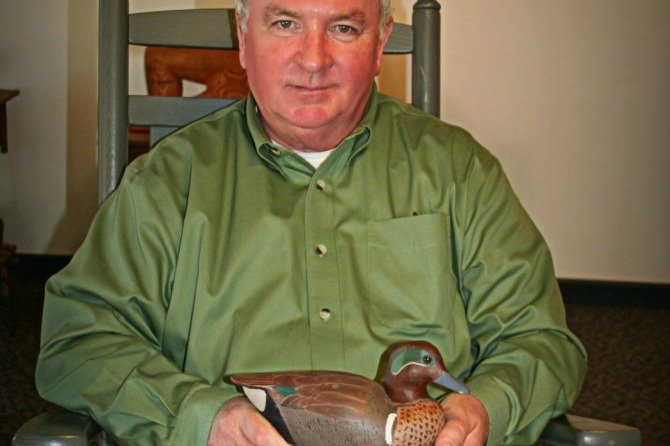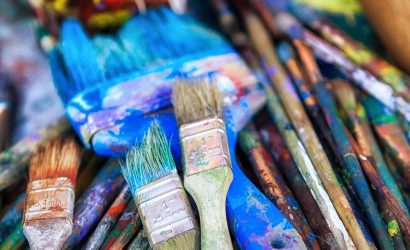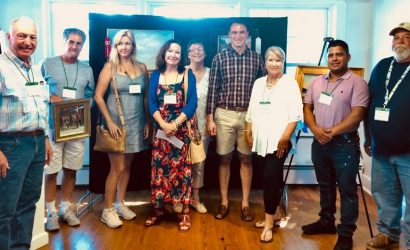Bishop’s Stock (202 W. Green Street, Snow Hill) is a fine art gallery that represents regional artists. The artwork changes monthly and is complimented by a wine gallery that changes seasonally. Both art and wine are curated to appeal to returning guests. On Tuesdays and Wednesdays, the gallery’s resident artist, Doug Fisher, carves functional and decorative decoys.
A duck, wildfowl, or hunting decoy is used to encourage wild birds to land near a hunting area within the range of a concealed hunter’s shot. These life-sized models have been used for hunting purposes for hundreds of years and have also become a collectable folk art favorite. Collecting and carving decoys is a popular hobby on the Eastern Shore.
Some are for display purposes, most are actually used to serve their original purpose – to fool waterfowl into coming closer to a hidden hunter.
“Duck hunters, like me, use these decoys when they’re hunting in nearby marshland,” said Doug Fisher, decoy artist, earlier this week. Fisher regularly demonstrates decoy carving techniques and trends mid-week at Bishop’s Stock.
“Before I moved to Snow Hill, one of my friends in Berlin taught me about decoys and wood carving techniques. He said I’d need a knife, a book, and a membership to the Ward Foundation in Salisbury.”
Fisher has been a member of the Ward Museum and carving birds ever since. The artist has spent the past 9 years creating decoys: 8 years on his own, the past year and a half at Bishop’s Stock.
“The foundation is great. It’s a way for me, as a carver, to see other carver’s work,” said the creative craftsman.
Since 1968, the Ward Foundation has been dedicated to promoting wildfowl art and preserving the legacy of Eastern Shore decoy carvers, Lemuel and Steve Ward. The brothers hailed from Crisfield, MD and carved between 27,000 and 40,000 birds during their lifetimes. Decoys produced by this duo, which opened a decoy business in 1926, are highly sought after today and can sell at auction for several tens-of-thousands of dollars.
On Tuesdays and Wednesdays, Fisher sits in a wooden rocking chair and chisels away at a block of cedar or cork in the Bishop’s Stock gallery. There are tools and sawdust covering his workspace, two large and friendly dogs sprawled out on the gallery floor, brilliant artwork hanging on the walls, and comforting music playing in the background.
“Working decoys from back in the day were made with cork. It floats well and is durable. When cedar became expensive, cork was inexpensive,” he explained.
The artist also noted that it is important for these carvings to float, especially when someone is using his product to hunt with, or when entering a competition.
“At wood carving competitions, the judges drop the decoys in a tub of water upside down. If the decoy doesn’t rise to the surface right-side-up, it doesn’t win. The decoy must be able to ‘right’ itself while in the water.”
Fisher is familiar with decoy competitions and has entered a few over the past few years. Since 1979, the Roland E. Powell Convention Center in Ocean City has been home to the Ward World Championship Wildfowl Carving Competition. The secret to getting a bird to constantly float right-side-up? Add a buoyant block of wood to the bottom side of the decoy or add a little weight with some lead.
Fisher always has more than one wildfowl carving in the works at one time. Currently displayed on his work bench in the gallery, the craftsman has three projects underway – 2 large pintails and 1 large black duck. Each bird is at a different stage in the carving regimen.
“I cut a block of wood with a band saw, use a power carver, sometimes a Dremel tool, a Fordham tool, several different bits, and a knife to shape the decoy.” Once the shape of the fowl has been established to Fisher’s liking, he skillfully uses oil-based paints to replicate the bird’s feathery and colorful markings.
The final result is a life-like wooden model of a real bird carefully carved, painted, and ready for use in a beautiful local marsh. Fisher’s carvings range in price from $125 for a miniature to $350 for a large full-sized decoy.
Doug Fisher demonstrates waterfowl carving techniques every Tuesday and Wednesday from 11 am to 6 pm, or from 6 – 8 pm during First Friday events, at Bishop’s Stock. Swing by to meet the artist, look at his work, and see the traditional wildfowl decoy carving process.









